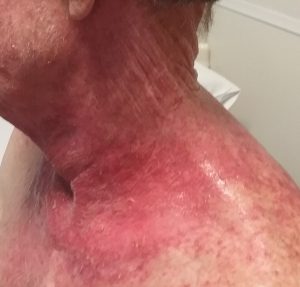 A silicone-based gel has shown efficacy in preventing or delaying the development of radiation dermatitis in patients receiving treatment for head and neck cancer.
A silicone-based gel has shown efficacy in preventing or delaying the development of radiation dermatitis in patients receiving treatment for head and neck cancer.
A Queensland study compared skin toxicity in almost 200 patients randomised to either StrataXRT or standard care of sorbolene from the start of radiotherapy until up to four weeks post-treatment.
The study found the StrataXRT group had a lower mean toxicity score by the end of the treatment than the sorbolene group (Common Terminology Criteria for Adverse Events Score 2.4 v 2.7).
Patients treated with the silicone gel also had a lower rate of grade 2 skin toxicity (80% v 90%) and grade 3 skin toxicity (28% v 45%) than the sorbolene-treated group.
Patients receiving StrataXRT also had a longer period without skin toxicity than the sorbolene group (4 v 3 weeks).
Secondary outcomes of pain, itching and skin-related quality of life were generally better but not significantly different in patients using the trial gel compared to the standard of care.
Lead researcher Professor Raymond Chan told the limbic a Cox regression analysis showed StrataXRT lead to a 41.0% reduced risk of developing grade 2 skin toxicity and a 49.4% reduced risk of developing grade 3 skin toxicity.
“By preventing transepidermal water loss and reducing mechanical friction we are preventing radiation dermatitis,” he said.
Professor Chan, from the Queensland University of Technology’s Institute of Health Biomedical Innovation, said it was very difficult to prevent grade 2 dermatitis.
However preventing the open wounds seen in grade 3 toxicity was much more important given the potential for infections.
He said the new treatment was more costly than sorbolene cream but saved other costs such as nursing hours related to managing skin toxicity.
The silicone gel was safe in that it did not reduce or enhance the dose of the radiation through the skin into the organ.
The study, funded by the manufacturer of StrataXRT, is the first to demonstrate the product’s efficacy in preventing radiation dermatitis.
“Although we have demonstrated this in head and neck cancer, we think it should be applicable to other cancers,” Professor Chan said.
“Queensland Health is leading a multicentre trial to try to replicate these findings in other cancers.”
The silicone gel is also being tested in the context of other burns and immune-related adverse events.